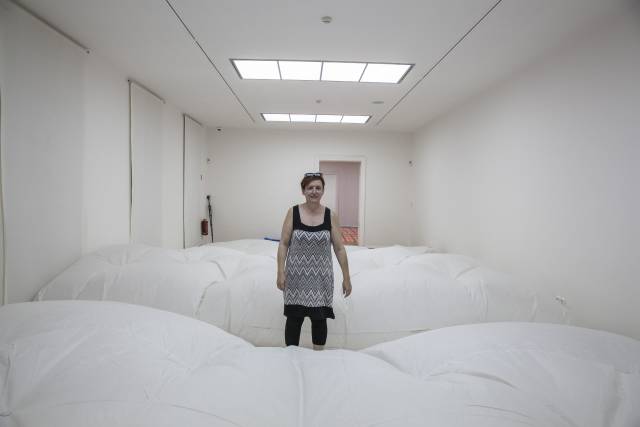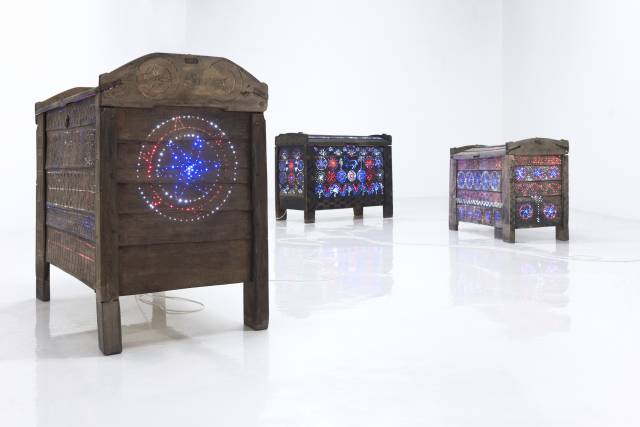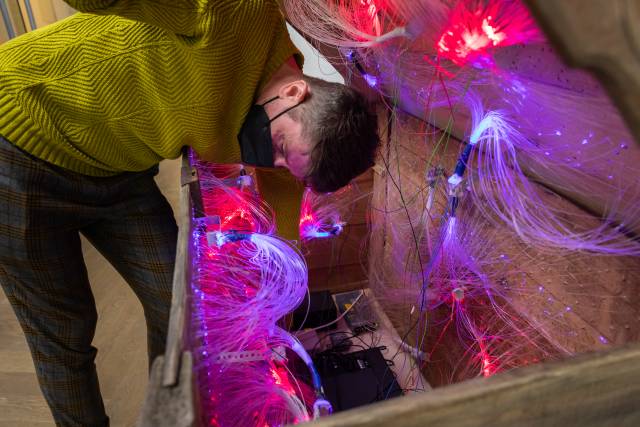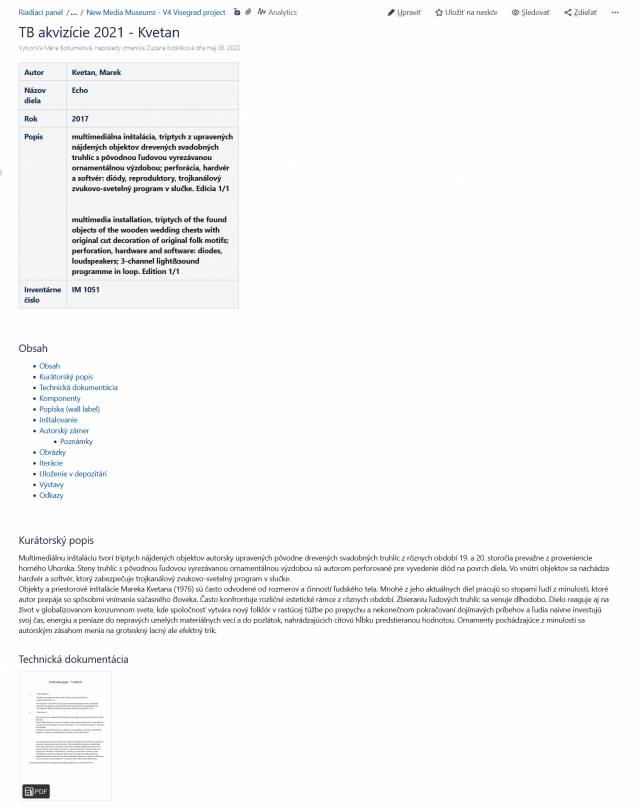New Media Museums Proceedings, 2022
New Media Documentation in the Slovak National Gallery
Other Media collection
The new media are other media, at least in the collections of the Slovak National Gallery (SNG). The SNG's Other Media collection was established after 1989, with its first acquisition being a fragment of the famous team work by artists Stano Filko, Miloš Laky and Ján Zavarský, White Space in White Space from 1974 (IM 001).1)
The collection can be divided into three lines. One consists of the collection and historical reconstruction of artworks belonging to the new tendencies of “other creativity”, to use the term of art historian Radislav Matuštík, which developed in Slovakia since the early 1960s in various positions and non-classical media outputs. Most of these works emerged from the unofficial and underground art scene as an alternative to the official doctrine of artistic production associated with academic education and the representation of socialist state culture. Future acquisitions to the collections aim to continue to record, research, collect, preserve and present works of conceptual art, action art and intermedia art, either through artefacts or, in the case of ephemeral works, through mediated photographic documentation. The second line of the collection is related to time-based media art (experimental film, video art, video installation) and the third line is related to “contemporary” installations and site-specific art. From the media point of view, the collection maps all media of creation and all non-classical positions and forms of artistic production; its focus is on research and registration of the experimental art scene in the sphere of contemporary art in Slovakia, within the limits of its possibilities.
Fig. 1: Ilona Németh installs her work Breathing Floor at the exhibition project Reconstructions. Photo: SNG Archive.
Due to the circumstances of its creation and short history, the Other Media collection contains various works from the 1960s and later. Some of them can be found on the intersection of conceptual art and sculpture, such as environments, objects and installations. Also included are time-based works such as films, video art and intermedia works such as documentaries, happenings and performances. The focus of the collection allows for future acquisitions of artworks combining multiple artistic approaches, as well as interdisciplinary works. Through the collaboration of several professional activities that enrich curatorial knowledge with the necessary technological and media skills, it will also be possible to engage in a more systematic collection and exploration of performance, sound and internet art. For this, however, new ways of recording and storing data need to be developed.
New media documentation v.1
Traditional gallery documentation in collections management systems (CMS) is not suitable for documenting new media. The data structures of most documentation schemes and collections management systems have been designed to meet the needs of painting, drawing and sculpture. The standards and rules reflected in the CMS we use do not allow us to record the complexity of new media in detail, or make it quite complicated.
The Central Register of Works of Art (CEDVU) is an heir to the tradition (or attempt at) central planning of the socialist state; it is both a union catalogue and a collections management system used by all state-registered galleries in Slovakia and developed and maintained by the Slovak National Gallery and an external development team. The CMS uses one scheme for cataloguing all different collections, created according to the decree of the Ministry of Culture (defining a minimum set of fields for cataloguing records for Slovak museums and galleries), rules and guidelines inspired by the standards Cataloguing of Cultural Objects and Categories for the Description of Works of Art (CDWA).2)
This system has not been able to embrace the changes brought about by new media - the diversity of materials, technologies and concepts. This is partly due to the historical debt of collections that (at least partially) focus on the acquisition of new media - except for the Slovak National Gallery's Other Media collection in the Intermedia collection of the Museum of Art in Žilina. Although many seminal and notable works were acquired in periods when collecting was on an upward curve, there are still gaps in these collections. The uncommon materials and difficult-to-maintain technologies used in many works of art have not been a focus of attention. The time allocated to curators caring for artworks has always been inadequate, the expertise of conservators who have had to deal with unfamiliar material has been lacking, just as documentation specialists have not been accustomed to contemporary art terms describing artworks. Many of the intermedia art positions in the collection are missing precisely because the expertise to preserve them is lacking. The challenge for the future will therefore also be to fill the gaps in the collection, which should at least to some extent reflect the development of art.
At the documentation level, one example of the shortcomings of the rules and schema we use is the lack of a component-level description of the work. At best, only measurements of the components that make up the artwork are provided, with no record of the material and other component-specific attributes. Because they are sparsely exhibited, many works have not been photographed, and installation guides have until recently been scarce and, if any, have not been part of the cataloging record in CMS or shared on an institutional repository.
In recent years, this has begun to change, thanks to projects and initiatives that are paving the way for the preservation and documentation of new media on the basis of the collaboration of experts from different fields.
Fig. 2: Catalogue record of Marek Kvetan, ECHO, in the CEDVU collections management system.
Reconstruction
One of the attempts to document the Other Media collection was the exhibition project Reconstructions.3) The aim of this “working exhibition,” which took place in 2015, was both to present to the public some of the works from the Other Media and Modern and Contemporary Art collections (which changed over time, they were not exhibited all at once), and to digitally document the process and the resulting installations as part of the Digital Gallery project. One outcome was video documentation of the installation process and informal interviews with the artists, along with multiple views of the installation created for print. Lacking a required rigour, the resulting videos are only partially usable as a means of documenting the installation process and the artists' motivation for using the materials (one of the most pressing issues being the common question of whether certain components are replaceable with other - contemporary - materials).
Wikification of new media documentation
Projects like the New Media Museums provide a good opportunity to look at the ways in which other institutions are tackling similar issues to ours. During our initial meetings with Dušan Barok, we were inspired by the best practices he shared with us, one example being SFMOMA Media Wiki. At SFMOMA, the MediaWiki platform is used as a documentation tool “to help represent the aboutness of contemporary art through reimagined, open-ended object records that can accommodate differing degrees of variability in art, and for which collaboration among individuals and teams is key.”4) The inherently unstable nature of new media is reflected and supported by the wiki, a low-barrier, collaborative tool used to document a list of equipment, technical narrative, software, installation guide, exhibition history with photo documentation, and multiple iterations of an artwork. Each iteration (the artwork's installation in a different environment and setting) is documented in the wiki, hence the need to change other parts of the documentation. If any of the iterations (artwork exhibitions) over time needed to replace or update any component of the artwork, the changes need to be reflected in the installation guide or software section of the documentation on the wiki page. The wiki does not replace the CMS, licensing database, or digital asset management systems (DAMS) used to store images from the exhibition. It serves as an interface between these various systems and processes.
Fig. 3: Marek Kvetan, ECHO (2017). Photo: Adam Šakový.
Documentation change
In addition to participation in the New Media Museum project and the inspiration of SFMOMA, the impetus for the change in the documentation of new media works at the SNG was the long-term focus on the acquisition of contemporary art, the plan for a major modernisation of the CEDVU CMS and the relocation of the collection to a new depository (in the newly renovated SNG building).
In 2021, the SNG received a generous donation for the acquisition of artworks from five contemporary Slovak artists. The acquisition and exhibition of these artworks (You Can't Buy a Butterfly5)) was an ideal opportunity to capture the complex information related to their installation, technical elements and other aspects: from A to Z - from the Artist's Idea to almost Zero questions. Given this complexity, we realized that one person (the curator) cannot do it alone, as is the case with traditional artworks such as paintings or drawings. Documenting artworks from new media collections in a new way is based on teamwork.
One of the acquired works is a triptych of wooden chests, ECHO, by the Slovak artist Marek Kvetan. It is a multimedia installation, a triptych of found objects of wooden wedding chests with original perforations (folk motifs), enriched with hardware and software (diodes, speakers, 3-channel light and sound program in a loop).
We use ECHO as a case study for new documentation. In addition to standard metadata such as description, title, date, technique, measurements and material, we added three important content pillars: artist's intent, installation guide and technical rider. Team members had two meetings before gathering and recording the information and process. The group consisted of a curator, a conservator-restorer, and colleagues from the digital technology and installation departments.
Artist's intent
In an interview with the artist, Lucia G. Stach, curator of the Other Media collection, asked him questions such as:
Why did you choose the material of wooden chests in conjunction with audiovisual elements, how does it relate to the folk theme?
What if one of the chests is damaged? What are some tips for a future restorer?
What should the sound volume be?
Should the chests be installed in a certain order?
The findings include:
- These are wooden chests in which, according to tradition, the bride receives a gift; the artist collects these chests and used three of them for this particular work.
- A three-channel light and sound programme as a reflection of “trávnice” (haymaking songs), traditional Slovak folk songs sung in meadows in mountainous areas of Slovakia, where a group of singers responds to the singing of other groups as an echo. The installation of three chests in a large room is ideal to make the sound effect noticeable.
- It was never meant to be installed in complete darkness so that the visitor could see the beauty and age of the chests and their ornaments.
- The sounds were inspired by the original shepherd songs of Svetozár Stračina, although they are all digital - even the sound of the shepherd's pipe (fujara) is artificial.
- It is the arch that bears the digital mark of our traditions.
- Light follows sound.
Installation guide
In this case, the installation instructions were not crucial because the artwork consists of only three components that need to be wired for electricity. However, it should include information on space requirements and constraints along with photo documentation.
Fig. 4: Marek Kvetan setting up ECHO at the You Can't Buy a Butterfly exhibition. Photo: Juraj Starovecký.
Technical rider
This part of the documentation was the most challenging. It started with the author's statement “just plug it in and adjust the volume” and ended with a six-page long instructions. Our colleagues required as much detail as possible about the LED lights, MP3 player, impulse source and radio frequency controller. The artist who worked with the sound and lighting programmer was invited for an interview and his contact details are listed in the guide.
Lessons learned
Prepare questions in advance for the artist and their collaborators. Otherwise, you may end up with a three-hour video interview with the artist with no answers that reflect the need for documentation.
Invite colleagues from other departments to join the process - their knowledge will help you ask more questions useful for documentation.
Plan for it - it's all time consuming.
Be uncompromising in audio and video recording quality. Effort is wasted when the audio is too unclear to understand all the words or when the images do not show specific details.
Transcribe the essential information from the recordings into text.
Next steps
It is essential that this pilot project becomes an ongoing internal process for documenting all newly acquired or exhibited new media artworks. All stakeholders should be informed about it and invited to participate. The next step is to upgrade our CMS and its data structure to be able to record the specifics of new media, expand the vocabularies (material, type of work), and modify the documentation methodology (describing the components of an artwork as items with specific materials and dimensions). The team should agree on templates for documentation on the wiki, establish a common template structure and quality standards for A/V recordings. Each artwork to be acquired for the Other Media collection will then be documented on the wiki using this common template (along with the CMS record). As we cannot expect all artworks acquired for the Other Media collection to be documented in this way in the near future, we will develop a plan to prioritise the artworks and select those that are most challenging to install or interpret.
Fig. 5: Wiki page for Marek Kvetan, ECHO.
See also video presentation You Can't Buy a Butterfly by Lucia Gregorová Stach and Mária Bohumelová in this volume.




